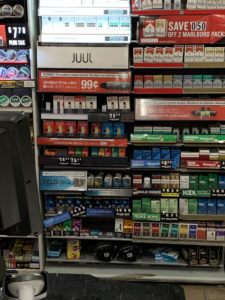Welcome to CounterTobacco.org’s “News and Research Roundup!” Each month we post a summary of the latest research, reports, and news stories on counteracting tobacco product sales and marketing at the point of sale (POS). Keeping up with what’s happening in the POS movement all across the country can help you choose policies and strategies that work best for your community. New research can help provide support for your work and evidence for the importance of the “War in the Store.” Have a story you don’t want us to miss? E-mail it to us!
New Research
POS Advertising, Marketing & Promotions
- Tobacco Advertisements: What Messages Are They Sending in African American Communities?, Health Promotion Practice
- In this study, researchers examined tobacco advertisements at 24 retail stores listed on CounterTools.org Store Mapper within 15 census tracts in Greensboro, North Carolina. Roughly 74% of the population was African American within the analyzed tracts. The purpose of this analysis was to determine the extent to which tobacco advertisements within African American communities use three prominent messaging strategies: reassure use is safe despite health risks, redirect attention
 from health risks to other product features, or incite bravery to use despite health risks. Researchers observed 165 ads from the 24 identified retailers, finding that the misdirection of attention strategy was used more frequently compared to reassurance and inducement to bravery. Misdirection ads frequently emphasized words, such as “enjoy,” “pleasure,” or “satisfies.” The study also found that tobacco messaging strategies are not uniformly applied across product types.
from health risks to other product features, or incite bravery to use despite health risks. Researchers observed 165 ads from the 24 identified retailers, finding that the misdirection of attention strategy was used more frequently compared to reassurance and inducement to bravery. Misdirection ads frequently emphasized words, such as “enjoy,” “pleasure,” or “satisfies.” The study also found that tobacco messaging strategies are not uniformly applied across product types. - Learn more about this study in our past webinar “Tobacco Ad Messaging Strategies at the Point of Sale – A Health Equity Focused Case Study”
- In this study, researchers examined tobacco advertisements at 24 retail stores listed on CounterTools.org Store Mapper within 15 census tracts in Greensboro, North Carolina. Roughly 74% of the population was African American within the analyzed tracts. The purpose of this analysis was to determine the extent to which tobacco advertisements within African American communities use three prominent messaging strategies: reassure use is safe despite health risks, redirect attention
- A Simulation of the potential impact of restricting tobacco retail outlets around middle and high schools on tobacco advertisements, Tobacco Control
- This study examined tobacco marketing at the tobacco retail outlets (TROs) within a half-mile of 53 middle and high schools in Texas. TROs within 1000 ft of schools had significantly more tobacco advertisements as compared with TROs located within 1000-2000 ft for all schools combined and middle schools. Simulation of the 1000 ft ban of TROs led to a slightly greater reduction in advertisements as compared with the 500 ft ban of TROs from other TROs. The reduction in all advertisement types was greater around middle schools and greatest for e-cigarettes.These results indicate that the implementation of a 1000 ft ban of TROs is one way to reduce adolescent exposure to tobacco advertising and help prevent or reduce the use of tobacco among adolescents.
- Retail Tobacco Marketing in Rural Versus Nonrural Counties: Product Availability, Discounts, and Prices, Health Promotion Practice
- Previous research has demonstrated geographic disparities in tobacco use, with higher rates observed among rural populations. Using the 2017 CaliforniaTobacco Retail Surveillance Study (CTRSS) data, researchers were able to assess product availability and promotion for several types of tobacco products (including vaping products), and differe
 nt measures of price for cigarettes and chewing tobacco, while comparing rural versus nonrural stores. The study compared both county-level and tract-level definitions of rural. Regardless of the definition, rural stores were more than twice as likely to sell roll-your-own tobacco and chewing tobacco. Rural-tract stores were almost twice as likely to sell little cigars/cigarillos. Additionally, significantly larger packs of cigarillos were sold for less than $1 in rural-county stores and rural-tract stores were significantly more likely to advertise discounts on chewing tobacco. These findings point to health equity concerns for rural communities and suggests that minimum price and/or package size policies could help to equalize prices in rural and nonrural areas.
nt measures of price for cigarettes and chewing tobacco, while comparing rural versus nonrural stores. The study compared both county-level and tract-level definitions of rural. Regardless of the definition, rural stores were more than twice as likely to sell roll-your-own tobacco and chewing tobacco. Rural-tract stores were almost twice as likely to sell little cigars/cigarillos. Additionally, significantly larger packs of cigarillos were sold for less than $1 in rural-county stores and rural-tract stores were significantly more likely to advertise discounts on chewing tobacco. These findings point to health equity concerns for rural communities and suggests that minimum price and/or package size policies could help to equalize prices in rural and nonrural areas.
- Previous research has demonstrated geographic disparities in tobacco use, with higher rates observed among rural populations. Using the 2017 CaliforniaTobacco Retail Surveillance Study (CTRSS) data, researchers were able to assess product availability and promotion for several types of tobacco products (including vaping products), and differe
Reports
- Tobacco 21 Grade Cards, The Preventing Tobacco Addiction Foundation
- Broken Promises to Our Children: A State-by-State Look at the 1998 Tobacco Settlement, Campaign for Tobacco Free Kids
- State Tobacco Tax Increases: Explanations and Sources for Projections of New Revenues & Benefits, Campaign for Tobacco-Free Kids
- State of Tobacco Control 2021, American Lung Association
Industry News
- FDA Warns 10 E-Liquid Companies, CSP Daily
- Altria Increases Cigarette Prices, CSP Daily
POS Policy in the Media
Tobacco 21
- ND senators vote to raise age to buy tobacco to 21, aligning with federal law, KXNet
- [MI] Rochester Hills proposes local ordinance to raise tobacco sale age to 21, The Oakland Press
- New Tennessee law raises age to purchase tobacco: Smoke shops, doctors react, News 9
- [PA] Age to buy tobacco products is going up, Erie News Now
- Colorado is only state in U.S. to earn straight ‘A’ grades for Tobacco 21 laws, enforcement, The Denver Gazette
Menthol and Other Flavored Tobacco Products
- [MO] ‘Social justice issue’: Kansas City officials try to ban flavored tobacco, fall short, Kansas City Star
- [CA] Inyo County residents’ signatures do not match county records on Tobacco Petitions, Sierra Wave Media
- [MT] Missoula County mulls extending city ban on flavored vaping products, Missoula Current
- [IL] Vernon Hills to consider moratorium on businesses interested in applying to sell flavored, vape tobacco products, Chicago Tribune

- Some state lawmakers want to ban all flavored tobacco products, including E-cigarettes, WTNH
- Lawmakers To Target Flavored Tobacco Products In Legislative Session, WNPR
- California’s ban on flavored tobacco sales blocked as referendum qualifies for ballot, LA Times
Tobacco Retailer Licenses
- [CO] Northglenn imposes new regulations on tobacco retailers, Brighton Standard Blade
- [NM] Department Of Health Celebrates The Implementation Of The Tobacco Products Act, Los Alamos Reporter
- [MA] Restricting The Sale Of Tobacco Products Regulation Will Be Effective From January 4, 2021 In Shrewsbury
- [CO] Rocky Ford City Council passes tobacco, marijuana ordinances, LA Junta Tribune
Preemption
- Missouri bill would allow cities to enact local tobacco taxes, Halfwheel
- [KY] Bills filed to let cities and counties regulate tobacco products and vaping materials more strictly than state, Hoptown Chronicle
Other
- First-Of-Its-Kind Tobacco Sales Ban Takes Effect In Beverly Hills, CBS Los Angeles
- Big Tobacco stands down as Colorado and Oregon hike cigarette taxes, Fortune
- FDA Warns Firms to Remove Unauthorized E-liquid Products from Market in First Letters Issued to Manufacturers that Did Not Submit Premarket Applications by Deadline, FDA News Release
- [WY] Tobacco Tax Increase Is Approved In Committee, Wyoming Public Media
- [NE] LPS to be first district in state to join vaping lawsuit, Nebraska News Channel
Find more stories in last month’s News and Research Roundup.
Know of a story that we missed? Email us, and we’ll be sure to include it in next month’s roundup


